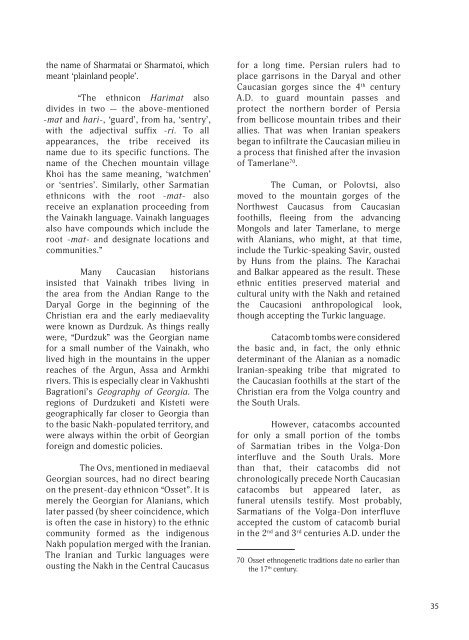The Diversity of the Chechen culture: from ... - unesdoc - Unesco
The Diversity of the Chechen culture: from ... - unesdoc - Unesco
The Diversity of the Chechen culture: from ... - unesdoc - Unesco
You also want an ePaper? Increase the reach of your titles
YUMPU automatically turns print PDFs into web optimized ePapers that Google loves.
<strong>the</strong> name <strong>of</strong> Sharmatai or Sharmatoi, which<br />
meant ‘plainland people’.<br />
“<strong>The</strong> ethnicon Harimat also<br />
divides in two — <strong>the</strong> above-mentioned<br />
-mat and hari-, ‘guard’, <strong>from</strong> ha, ‘sentry’,<br />
with <strong>the</strong> adjectival suffix -ri. To all<br />
appearances, <strong>the</strong> tribe received its<br />
name due to its specific functions. <strong>The</strong><br />
name <strong>of</strong> <strong>the</strong> <strong>Chechen</strong> mountain village<br />
Khoi has <strong>the</strong> same meaning, ‘watchmen’<br />
or ‘sentries’. Similarly, o<strong>the</strong>r Sarmatian<br />
ethnicons with <strong>the</strong> root -mat- also<br />
receive an explanation proceeding <strong>from</strong><br />
<strong>the</strong> Vainakh language. Vainakh languages<br />
also have compounds which include <strong>the</strong><br />
root -mat- and designate locations and<br />
communities.”<br />
Many Caucasian historians<br />
insisted that Vainakh tribes living in<br />
<strong>the</strong> area <strong>from</strong> <strong>the</strong> Andian Range to <strong>the</strong><br />
Daryal Gorge in <strong>the</strong> beginning <strong>of</strong> <strong>the</strong><br />
Christian era and <strong>the</strong> early mediaevality<br />
were known as Durdzuk. As things really<br />
were, “Durdzuk” was <strong>the</strong> Georgian name<br />
for a small number <strong>of</strong> <strong>the</strong> Vainakh, who<br />
lived high in <strong>the</strong> mountains in <strong>the</strong> upper<br />
reaches <strong>of</strong> <strong>the</strong> Argun, Assa and Armkhi<br />
rivers. This is especially clear in Vakhushti<br />
Bagrationi’s Geography <strong>of</strong> Georgia. <strong>The</strong><br />
regions <strong>of</strong> Durdzuketi and Kisteti were<br />
geographically far closer to Georgia than<br />
to <strong>the</strong> basic Nakh-populated territory, and<br />
were always within <strong>the</strong> orbit <strong>of</strong> Georgian<br />
foreign and domestic policies.<br />
<strong>The</strong> Ovs, mentioned in mediaeval<br />
Georgian sources, had no direct bearing<br />
on <strong>the</strong> present-day ethnicon “Osset”. It is<br />
merely <strong>the</strong> Georgian for Alanians, which<br />
later passed (by sheer coincidence, which<br />
is <strong>of</strong>ten <strong>the</strong> case in history) to <strong>the</strong> ethnic<br />
community formed as <strong>the</strong> indigenous<br />
Nakh population merged with <strong>the</strong> Iranian.<br />
<strong>The</strong> Iranian and Turkic languages were<br />
ousting <strong>the</strong> Nakh in <strong>the</strong> Central Caucasus<br />
for a long time. Persian rulers had to<br />
place garrisons in <strong>the</strong> Daryal and o<strong>the</strong>r<br />
Caucasian gorges since <strong>the</strong> 4 th century<br />
A.D. to guard mountain passes and<br />
protect <strong>the</strong> nor<strong>the</strong>rn border <strong>of</strong> Persia<br />
<strong>from</strong> bellicose mountain tribes and <strong>the</strong>ir<br />
allies. That was when Iranian speakers<br />
began to infiltrate <strong>the</strong> Caucasian milieu in<br />
a process that finished after <strong>the</strong> invasion<br />
<strong>of</strong> Tamerlane 70 .<br />
<strong>The</strong> Cuman, or Polovtsi, also<br />
moved to <strong>the</strong> mountain gorges <strong>of</strong> <strong>the</strong><br />
Northwest Caucasus <strong>from</strong> Caucasian<br />
foothills, fleeing <strong>from</strong> <strong>the</strong> advancing<br />
Mongols and later Tamerlane, to merge<br />
with Alanians, who might, at that time,<br />
include <strong>the</strong> Turkic-speaking Savir, ousted<br />
by Huns <strong>from</strong> <strong>the</strong> plains. <strong>The</strong> Karachai<br />
and Balkar appeared as <strong>the</strong> result. <strong>The</strong>se<br />
ethnic entities preserved material and<br />
cultural unity with <strong>the</strong> Nakh and retained<br />
<strong>the</strong> Caucasioni anthropological look,<br />
though accepting <strong>the</strong> Turkic language.<br />
Catacomb tombs were considered<br />
<strong>the</strong> basic and, in fact, <strong>the</strong> only ethnic<br />
determinant <strong>of</strong> <strong>the</strong> Alanian as a nomadic<br />
Iranian-speaking tribe that migrated to<br />
<strong>the</strong> Caucasian foothills at <strong>the</strong> start <strong>of</strong> <strong>the</strong><br />
Christian era <strong>from</strong> <strong>the</strong> Volga country and<br />
<strong>the</strong> South Urals.<br />
However, catacombs accounted<br />
for only a small portion <strong>of</strong> <strong>the</strong> tombs<br />
<strong>of</strong> Sarmatian tribes in <strong>the</strong> Volga-Don<br />
interfluve and <strong>the</strong> South Urals. More<br />
than that, <strong>the</strong>ir catacombs did not<br />
chronologically precede North Caucasian<br />
catacombs but appeared later, as<br />
funeral utensils testify. Most probably,<br />
Sarmatians <strong>of</strong> <strong>the</strong> Volga-Don interfluve<br />
accepted <strong>the</strong> custom <strong>of</strong> catacomb burial<br />
in <strong>the</strong> 2 nd and 3 rd centuries A.D. under <strong>the</strong><br />
70 Osset ethnogenetic traditions date no earlier than<br />
<strong>the</strong> 17 th century.<br />
35

















